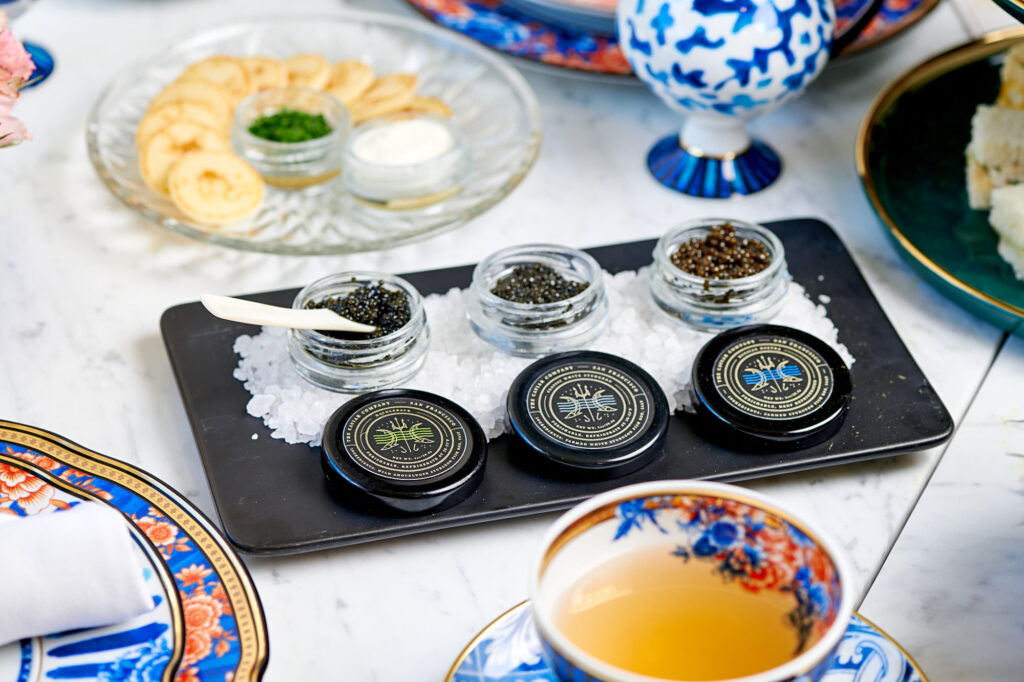
Everything You Ever Wanted to Know About Ordering Caviar (But Were Too Embarrassed to Ask)
Here’s the roe low down.

Costi Moculescu/500px/Getty Images
Caviar is more than a buzzy ingredient we’re seeing layered over fried chicken, spaghetti, and ice cream: It’s the epitome of elegance. Whether you’re enjoying some salmon roe with a tuna fish sandwich or white sturgeon with champagne, a little bit of fish egg has the power to make any meal fancy.
But herein lies the problem: Since caviar is one of the finer things in life, it can feel a little intimidating to add it to your diet. How do you order caviar? Is there a right way to eat it? And, for some, what even is caviar? (The answer to that one is more complicated than you’d think.) Don’t worry, help is on the way. Here, two roe pros are answering all your biggest caviar questions. Yes, even the ones you’ve been too embarrassed to ask.

The Caviar Co.
Okay, So What Is Caviar?
Salmon, sturgeon, tobiko—it’s all caviar, right? Well, not exactly. “While all caviar is roe, not all roe is caviar,” says Petra Higby, CEO and co-founder of The Caviar Co. in San Francisco. “Caviar, by definition, is salt-cured eggs of sturgeon fish.” Even within the official definition of caviar, there are 27 different species of sturgeon, so you have a lot of options.
Similar to wine, the caviar’s taste will depend on its growing conditions such as water temperature, depth, and darkness. As a result, you can expect small nuances across all the species. “Taste is subjective but generally, good caviar should have a rich, buttery flavor with a subtle sea essence,” says Ali Bolourchi, president of Tsar Nicoulai Caviar Farm in Wilton, California. “It shouldn’t be overly salty.”

Natalie_magic/Getty Images
What’s the Best Type of Caviar?
While many people might associate luxurious caviar exclusively with the Caspian Sea—likely due to the long-standing reputation of species like Beluga and Osetra—pros insist there are more delicious varieties to enjoy.
While Higby refers to Ostera as the “crème de la crème of caviar,” she is quick to point out that Beluga is actually an endangered species that is banned in many areas. As a replacement, she recommends trying Kaluga Hybrid. “[It] has it all: firmer texture, more noticeable pop, and gorgeous earthy flavor,” she explains. “It’s uniquely nutty with deep umami notes and a favorite of Michelin star chefs.”
Higby also calls Siberian Sturgeon a favorite due to its soft texture and distinct flavor profile. “It is pleasantly nutty and briny with a noticeably clean finish and notes of parmesan cheese,” she adds.
For an option that’s both scrumptious and sustainable, Bolourchi says to reach for white sturgeon, which is native to Northern California. “While the white sturgeon may not boast the same size or fame as its Caspian counterparts, its roe is celebrated for its rich flavor and unique texture,” he says. “With an increasing shift toward sustainable practices in aquaculture, locally-farmed white sturgeon caviar is becoming a more accessible choice for consumers.”

Jermaine Ee/Unsplash
How Should You Order Caviar?
Whether you’re ordering some roe at a restaurant or buying some to enjoy at home, make sure to do your research. If a menu or packaging simply refers to its offering as “caviar” instead of denoting the type of sturgeon the roe is sourced from, there may be something fishy—literally.
“If they can tell you where it’s sourced from, what type of caviar it is, if it’s farmed or imported and describe its flavor profile, you can be confident you are getting a quality product and not being served caviar that is marked up or inaccurately labeled,” Higby says.
Price is another thing to consider. According to Higby, The Caviar Co.’s prices range from $12 to $170 per ounce. “One ounce may seem small, but it can be perfect for two to four people depending on the application,” she explains. For a budget-friendly option, she recommends Hackleback and Paddlefish. “They’re approachable ‘everyday’ caviars as we like to call them that can run from $40 to $46 an ounce and pair great with seafood,” she says. Meanwhile, you’ll likely spend more on a higher-end varietal like Ostera and White Sturgeon.

LauriPatterson/Getty Images
How Are You Supposed to Serve Caviar?
Chilled, always. “Many are unaware of variances in temperature that occur in a typical home refrigerator—stemming from frequent opening and closing—can drastically reduce the shelf life of the product,” Bolourchi says. “As the caviar is exposed to fluctuating temperatures, it becomes more susceptible to spoilage.”
Caviar does spoil quickly, so you’ll want to devour the entire container shortly after opening it. Another pro tip: Be particular about your serveware. “Metal has an unpleasant effect on caviar, so it is recommended that one use Mother of Pearl, glass, wood, horn, gold, or a neutral surface like one’s hand for serving,” Higby shares. “Contrary to what would be thought, plastic also works well if in a pinch.”

The Caviar Co.
What Pairs Best with Caviar?
Though caviar might be added to everything these days, Bolourchi says the best pairings are often the most simple. “Simple, neutral accompaniments are best to let the caviar shine and best paired with chilled vodka or champagne or sparkling wine,” “Avoid strong-flavored wines or cocktails.” While you can’t go wrong with small pancakes called blinis, crème fraîche, or lightly toasted bread, Higby recommends trying caviar on its own. “Caviar bumps are the most traditional way to taste caviar,” she says. “With a caviar bump, you eat the caviar directly off the back of your hand.” Bon appétit!
